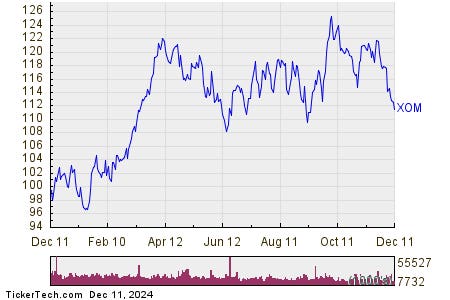Exxon Mobil (XOM), one of the world’s largest publicly traded international oil and gas companies, experienced a dip in its stock price on Wednesday, prompting a closer look at its technical indicators and market performance. The company’s shares traded as low as $111.42, entering oversold territory as defined by the Relative Strength Index (RSI). This momentum indicator, ranging from 0 to 100, helps identify potential buying or selling opportunities based on the speed and magnitude of price movements. An RSI below 30 typically suggests oversold conditions, implying that the selling pressure might be waning and a price rebound could be on the horizon.
XOM’s RSI reading of 29.5 on Wednesday signaled a potential turning point for the stock. This figure significantly contrasts with the average RSI of 47.1 for the broader energy sector, as tracked by Energy Stock Channel. Furthermore, comparing XOM’s RSI with related commodities reveals a substantial divergence. West Texas Intermediate (WTI) crude oil, a benchmark for global oil prices, registered an RSI of 50.0, while Henry Hub natural gas, a key natural gas pricing point, stood at 61.1. The 3-2-1 crack spread, an indicator of refining profitability, showed an even higher RSI of 79.8. This disparity suggests that XOM’s price decline might be decoupled from the underlying commodity markets and could represent a stock-specific correction rather than a broader industry downturn.
For bullish investors, XOM’s low RSI could present an attractive entry point. The oversold condition often indicates that the selling pressure is reaching its exhaustion phase, paving the way for potential price recovery. While past performance doesn’t guarantee future results, understanding the stock’s historical price range can offer valuable context. Over the past year, XOM’s shares have fluctuated between a low of $95.77 and a high of $126.34. The dip to $111.42, therefore, places the stock closer to its 52-week low, potentially signaling a discounted buying opportunity for those anticipating a price rebound. However, it’s crucial to consider other market factors and conduct thorough research before making any investment decisions.
The analysis of XOM’s RSI and price performance provides valuable insights for investors, particularly those employing technical analysis strategies. The oversold condition, coupled with the stock trading closer to its 52-week low, might suggest a favorable risk-reward profile for potential buyers. However, it’s imperative to remember that technical indicators are just one piece of the puzzle. A comprehensive investment strategy should encompass fundamental analysis, considering factors such as the company’s financial health, industry outlook, and macroeconomic environment. Additionally, external factors like geopolitical events and regulatory changes can significantly influence energy prices and, consequently, XOM’s stock performance.
It’s crucial to recognize that market conditions are dynamic and constantly evolving. While technical indicators like RSI can offer valuable insights, they are not foolproof predictors of future price movements. The oversold condition doesn’t guarantee a price reversal, and the stock could continue to decline if negative market forces persist. Therefore, investors should employ a diversified approach, managing risk by spreading their investments across various asset classes and sectors. Consulting with a financial advisor can also provide personalized guidance tailored to individual investment goals and risk tolerance.
In conclusion, XOM’s entry into oversold territory, indicated by its low RSI, warrants attention from investors. The disconnect between XOM’s RSI and those of related energy commodities suggests a potential stock-specific opportunity. However, relying solely on technical indicators can be risky. A comprehensive investment approach that integrates fundamental analysis, considers market dynamics, and incorporates risk management strategies is essential for making informed investment decisions. While XOM’s current situation might present a potential buying opportunity, thorough due diligence and a holistic investment strategy are paramount for achieving long-term financial goals.










